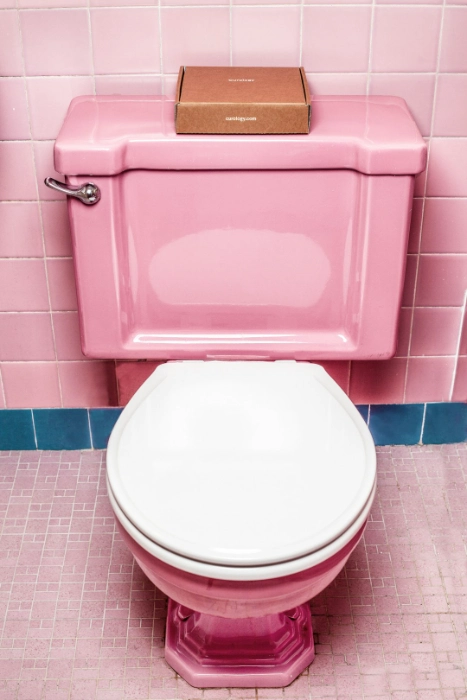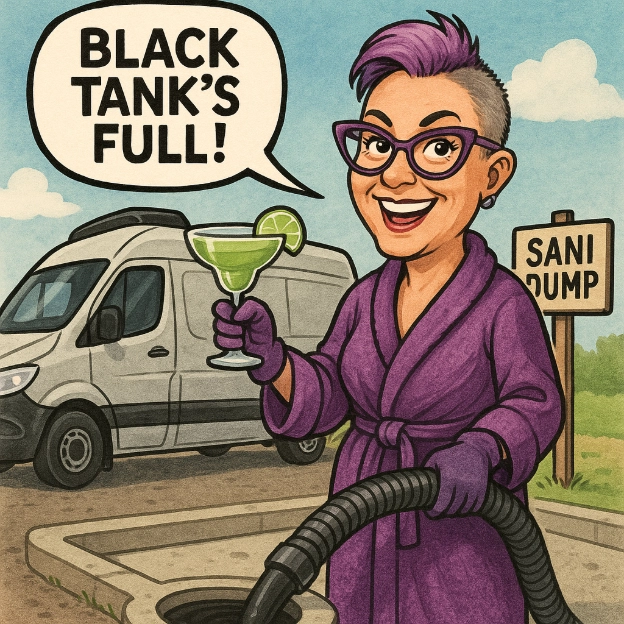Camper Black Tank Emptying Made Simple

Disclosure: Some of the links in this article may be affiliate links, which can provide compensation to me at no cost to you if you decide to purchase. This site is not intended to provide financial advice and is for entertainment only.
This one’s for the van lifers and RV enthusiasts alike. Maybe you’re elbow-deep in a build and wondering if having a black tank is even worth it. I get that. There are alternatives, sure—but for me? I wouldn’t be without a toilet in my rig. Whether it’s an overnight at a rest stop, boondocking in the desert, or stuck in traffic on a road trip, having a toilet on board is non-negotiable.
And yes, figuring out how to empty your camper black tank can feel intimidating at first. But it doesn’t have to be a disaster. This post walks you through the basics, the gear, and the mindset you need to handle waste with minimal drama and zero fear.
How to Dump Your Camper Black Tank Safely
Let’s take the fear out of this. Dumping your black tank isn’t rocket science—it’s just a system. Here’s the step-by-step guide to keep things clean and drama-free:
Close your grey tank the day before. If you usually keep it open, close it ahead of time so there's a decent amount of grey water built up. You'll use it to flush out the hose after the black tank is dumped.
Gear up. You’ll need a sewer hose (aka “stinky slinky”), disposable gloves, a hose support if needed, and ideally a clear sewer hose adapter so you can see when everything runs clean.
Connect your sewer hose. Attach one end to your RV's waste outlet and the other securely to the dump station inlet. Make sure the hose is properly supported and not kinked.
Check the connection. Open the grey tank valve just a little and let a bit of water out. This ensures your hose is properly sealed and there are no small leaks or surprises.
Dump the black tank. Open the black valve and let it empty completely. You’ll see the flow through your clear adapter if you're using one.
Rinse the black tank. If you have a built-in flush system, now’s the time to use it. If not, a separate rinse hose or flush wand can help.
Dump the grey tank. Open the grey valve. This cleaner water helps rinse out the sewer hose.
Close valves and disconnect. Make sure both valves are closed before removing the sewer hose. Keep the hose angled to drain fully into the dump station.
Rinse and store. Give your sewer hose a final rinse with a designated non-potable hose. Stow it in a separate compartment from your fresh water gear.
Treat the tank. Add water and a dose of an enzyme treatment like Happy Camper to keep things fresh until the next dump.
For more on keeping your tank smelling good, check out our full RV black tank cleaner guide.
Why Waste Management Is Simpler in a Van
Compared to massive RVs with complicated plumbing, most vans have smaller tanks and more mobile setups. That means it’s easier to pack up and hit a dump station when needed. You’re more nimble—less gear, fewer pipes, and usually just one person dealing with the mess.
There’s also a wide range of toilet options available for van dwellers. Some vans run a basic cassette toilet setup—easy to dump at any public restroom or sani-dump. Others use a small black tank with a traditional flush toilet setup. Composting toilets, while popular, are bulky and take up a lot of space. The same goes for incinerating toilets—they work, but they’re often too large and too power-hungry for smaller rigs.
Other common options include:
Cassette toilets: Easy to remove and dump, especially for weekend use. Check out Amazon's best reviewed cassette toilet here:
Bucket systems: Lightweight and ultra-basic, but not great for long-term living. You can DIY this very easily or check out these collapsible versions from amazon:
Dry flush toilets: Wrap waste in an odor-sealed liner with each use—clean, but pricier and not ideal for frequent use. Check out the Modiwell version:
Composting toilets: Separate solids and liquids with no water—eco-friendly but bulky and requires frequent upkeep.
Incinerating toilets: Burn waste to sterile ash—no dumping, but power-hungry and too large for most van builds. I had trouble finding any of these on Amazon but here's a link to a very informative website called Incinerating Toilets.
For full-timers or anyone living on the road more than a few days at a time, a black tank system remains the most comfortable and hygienic option. Once you know how to manage it, it's no big deal.
The Macerator Pump: Your Secret Weapon
Macerator pumps grind black tank waste into a slurry, making it easy to pump through a garden hose—even uphill, even 100 feet away. If you’re moochdocking near a house or close to a septic cleanout, this setup lets you stay parked and still drain your tank like a boss.
Some rigs come with built-in macerators, but you can also buy one as an add-on. If you do, get one with a clear connector so you can see when the tank’s fully flushed. It also saves your wrists—some pump fittings are infuriatingly tight. Here is the macerating pump I personally have and use and it's available on Amazon
Portable Waste Totes: Roll and Dump
Don’t want to deal with pumping? A portable waste tote is a solid plan B. These wheeled containers let you dump your black tank into the tote, then roll or drive it to a nearby station.
Totes come in different sizes, so get one that matches or slightly exceeds your black tank’s capacity. They’re heavy when full, so consider how you’ll move it—tow it with a hitch, load it into a truck bed, or use a ramp.
Pro tip: if your RV drain is too low to gravity-fill the tote (like in some vans), you can use a macerator to fill it instead.
Check out the most popular and best reviewed Camco portable waste totes on Amazon:
When Things Go Wrong
Even with the best setup, things go sideways. Like the time I drained the black tank without checking that the 'stink slinky' didn't have any holes. This is exactly why I always run a bit of grey water waste through first. If something goes wrong—clogs, mystery smells, leaks—you’ll need some basic repair know-how which is why I took an online RV training course.
If you want to build your skills and stop fearing your rig? Check out this RV repair school—it could save you thousands.
Before You Hit the Road
If you’re prepping for a road trip, don’t forget to drain and clean your black tank first. A little enzyme treatment and a full rinse go a long way toward a smell-free journey.
For more trip prep essentials, check out this road trip checklist. A clean tank is just the beginning.
Final Thoughts
You don’t need to fear your black tank. Whether you’re using a macerator pump to drain uphill or rolling a tote across a field, you’ve got options. Learn your system, test your gear, and don’t wait until you’re full to make a plan.
Black tank dumping may never be glamorous—but it can absolutely be simple.
Rolling Solo is my brutally honest guide to solo vanlife—how to prep, what to expect, and why it's still worth it even when everything leaks. Grab it here for $5 CAD.
Author: Royanne, full-time road dweller and the voice behind MissadVANture.
Disclosure: Some of the links in this article may be affiliate links, which can provide compensation to me at no cost to you if you decide to purchase. This site is not intended to provide financial advice and is for entertainment only.

